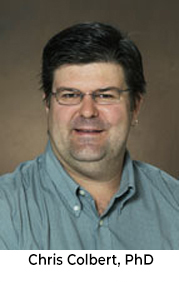NDSU receives grant for state-of-the-art biomedical and structural biology instrument

Researchers at NDSU have been awarded an S10 grant from the National Institutes of Health (NIH) that will provide a state-of-the-art instrument called an analytical ultracentrifuge (AUC). The AUC is a key analytical instrument that isolates, identifies, and measures the individual paths of molecules as they move within a solution. This AUC data can be analyzed to determine molecular properties such as size, shape, heterogeneity (or variability), structure, and assembly dynamics of individual molecules, complexes of molecules, and nanomaterials. This data will provide researchers with important information about how these materials interact in solution.
“This instrument will provide us with the capability to perform experiments that have not previously been possible at NDSU,” commented NDSU chemistry and biochemistry professor Christopher Colbert. “It will help us understand how molecules interact with each other and with the various solutions they’re within, which will provide useful information for research activities involving drug delivery, virus assembly, and nanoparticles. Our AUC will truly support the expansion of biomedical and structural biology research at NDSU.”
Colbert, who was instrumental in obtaining the NIH grant, is the PI on the award and will be a major user of the AUC. Previously, NDSU was not eligible for NIH S10 grants due to rules requiring a minimal number of highly funded NIH users at an institution. Colbert realized that the rules had changed and NDSU researchers could now apply for this funding mechanism. An added benefit of this funding mechanism was that the institution was not required to provide a match for buying the instrument. Colbert assembled a team of eight additional researchers with very diverse research interests who would be major users of the device, along with an additional four who would be minor users. Colbert and his team then wrote the successful proposal, which received a perfect score, for the nearly $400,000 instrument.
The instrument to be purchased is the Beckman Optima AUC and is considered the state-of-the art for AUC. The unit will be housed in the X-Ray Crystallography facility, which is managed by NDSU chemistry and biochemistry. Besides NDSU users, Colbert notes that external users will also have paid access to the device. “Both local companies and institutions will have an interest in the NDSU AUC, especially given that the next closest AUC would be in Minneapolis, Omaha, or Bozeman.”
In addition to Colbert, the following NDSU researchers contributed to the proposal as major users of the AUC: Yagna Jarajapu, associate professor of pharmaceutical sciences; Sangita Sinha, professor of chemistry and biochemistry; Sheela Ramamoorthy, associate professor of microbiology; Mohiuddin Quadir, associate professor of coatings and polymeric materials; Gudrun Lukat-Rodgers, research professor of chemistry and biochemistry; Kenton Rodgers, professor of chemistry and biochemistry; and Erik Hobbie, professor of physics. The minor users that contributed to the proposal are: Sathish Venkatachalem, associate professor of pharmaceutical sciences, Sijo Mathew, assistant professor of pharmaceutical sciences, Zhongyu Yang, assistant professor of chemistry and biochemistry, and Stefan Vetter, research associate professor of pharmaceutical sciences.
The NDSU AUC is supported by NIH project number 1S10OD030341-01


